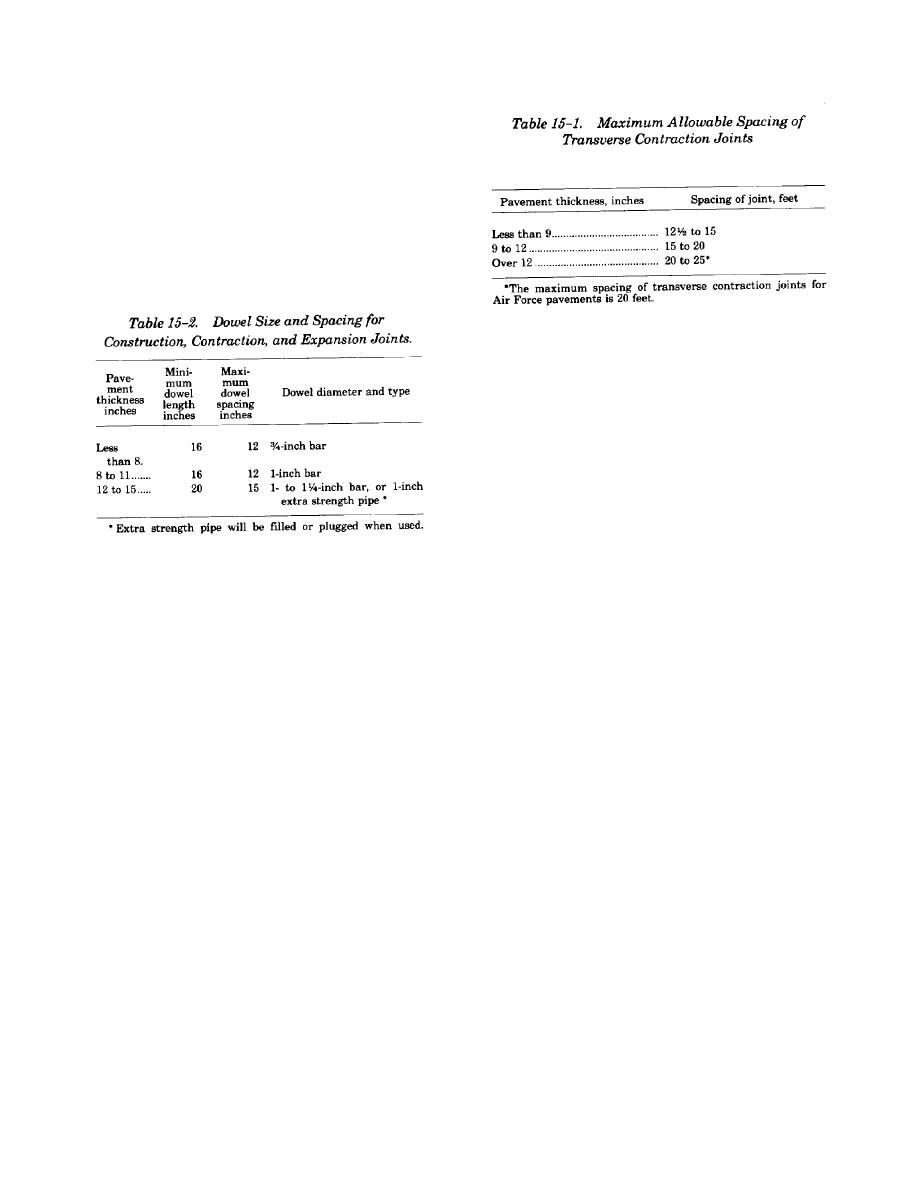
TM 5-822-5/AFM 88-7, Chap. 1
equal dimensions under traffic. Therefore, it is
desirable, insofar as practicable, to keep the length
and width dimensions as nearly equal as possible. In
no case should the length dimension (in the
direction of paving) exceed the width dimension
more than 25 percent. Where it is desired to exceed
the joint spacing (in table 15-1), a request must be
submitted to HQUSACE (CEMP-ET) or the
appropriate Air Force Major Command outlining
local conditions that indicate that the proposed
change in joint spacing is desirable.
(b) For plain concrete pavements,
deformed tie bars will be required in longitudinal
contraction joints that fall 15 feet or less from the
free edge of paved areas that are 100 feet or greater
in width. The deformed tie bars will be e inch in di-
ameter, 30 inches long, and spaced on 30-inch cen-
ters. In addition, longitudinal contraction joints
placed along the center line of paving lanes that
have a width greater than the maximum spacing of
transverse contraction joints will be tied using tie
bars of the above-mentioned dimensions (fig 15-3).
b. Construction joints. Construction joints may
(4) Spacing of longitudinal contraction
be required in both the longitudinal and trans-verse
joints. Contraction joints will be placed along the
directions. Longitudinal construction joints,
center line of paving lanes that have a width greater
generally spaced 20 to 25 feet apart but which may
than the determined maximum spacing of trans-
reach 50 feet apart, depending on construction
verse contraction joints in table 15-1. These joints
equipment capability, will be provided to separate
may also be required in the longitudinal direction
successively placed paving lanes. Transverse con-
for overlays, regardless of overlay thickness, to
struction joints will be installed at the end of each
match joints existing in the base pavement unless a
day's paving operation, and at other points within a
bond-breaking medium is used between the overlay
paving lane where the placing of concrete is dis-
and base pavement or the overlay pavement is
continued a sufficient length of time for the con-
reinforced.
crete to start to set. All transverse construction
joints should be located in place of other regularly
spaced transverse joints (contraction or expansion
(5) Doweled and tied contraction joints.
types). There are several types of construction
joints available for use, as shown in figure 15-4 and
as described below. The selection of the type of
(a) Dowels are required in transverse con-
construction joint will depend on such factors as the
traction joints for plain concrete pavements for class
concrete placement procedure (formed or slip-
A and B roads and streets, reinforced concrete
formed) and foundation conditions.
(1) Doweled joint. The doweled joint is the
pavements that use slab lengths greater than those
in table 15-1, and in the last joint at ends of long
best joint for providing load transfer and
paving lanes such as large storage and parking
maintaining slab alignment. It is a desirable joint for
areas. These dowels are required to ensure good
the most adverse conditions such as heavy loading,
joint load transfer under heavy, repeated loads and
high traffic intensity, and lower strength
under conditions where conventional contraction
foundations. However, because the alignment and
joints may have inadequate load transfer because of
placement of the dowel bars are critical to
excessive joint opening. Table 15-2 presents the
satisfactory performance, this type of joint is
size and spacing of dowels.
difficult to construct, especially for slipformed
concrete. However, the doweled joint is required
15-15



 Previous Page
Previous Page
